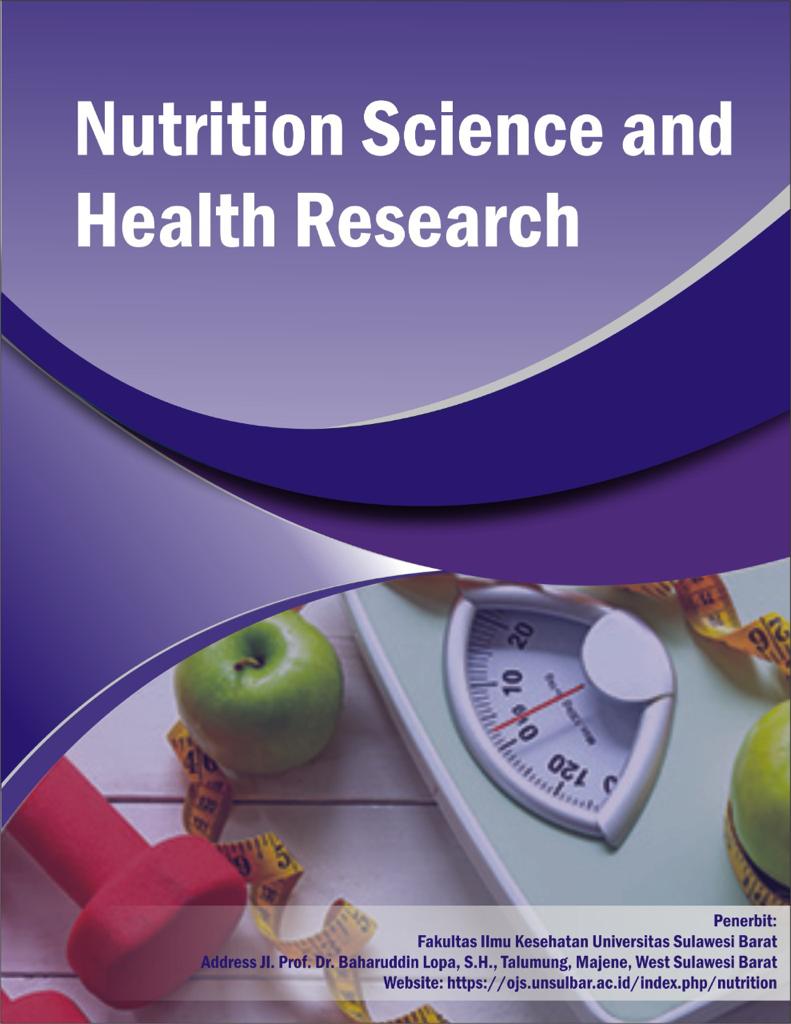Main Article Content
Abstract
Underweight is the most common condition of malnutrition in children aged five years and under and is caused by food intake that does not meet the physiological needs of the body. A lack of food intake can occur due to a lack of energy from staple food sources. Underweight in children under five years old can be caused by various factors, including a lack of knowledge about nutrition and health of parents, especially mothers and the socioeconomic situation of the family is one of the factors that determine the amount of food available in the family so that it also determines the nutritional status of the family. The purpose of this study was to determine the relationship between maternal nutritional knowledge and the incidence of underweight in toddlers in Bonde Utara Village, Pamboang District, Majene Regency. The type of research used is quantitative research with a cross sectional design and the sampling technique is purposive sampling. The analysis test used was chi-square test. The results showed a significant relationship between maternal nutrition knowledge (p=0.03 <0.05), an intensive nutrition education program is needed to reduce the prevalence of underweight in North Bonde Village.
Keywords
Article Details

This work is licensed under a Creative Commons Attribution-NonCommercial-ShareAlike 4.0 International License.
References
- Afraihana, N., Rizqiawan, A., Istianah, I., & Afrizal, S. H. (2024). Hubungan Pengetahuan, Sikap Ibu, Dan Pola Asuh Ibu Dengan Status Gizi Balita Usia 2-5 Tahun. Binawan Student Journal, 6(1), 26–35. https://doi.org/10.54771/e8ya8822
- Dinas Kesehatan Majene. 2023. Data Dinas Kesehatan Majene.
- Gahayu S A. 2019. Metodologi PenelitianKesehatan. Yogyakarta : Deepublish
- Kementerian Kesehatan RI. (2023). Survei Kesehatan Indonesia (SKI) dalam Angka. Kementerian Kesehatan RI.
- Notoatmodjo, S. 2010. Pendidikan Dan Perilaku Kesehatan. Jakarta. Rineka Cipta.
- Notoatmojo, S. (2012). Metodologi Penelitian Kesehatan. Jakarta: Rineka Cipta.
- Notoatmodjo, S. (2014) Ilmu Perilaku
- Kesehatan. Jakarta: Rineka Cipta.
- Nurmaliza, N., & Herlina, S. (2019). Hubungan Pengetahuan dan Pendidikan Ibu terhadap Status Gizi Balita. Jurnal Kesmas Asclepius, 1(2), 106–115. https://doi.org/10.31539/jka.v1i2.578
- Puskesmas Pamboang. 2024. Data Puskesmas Pamboang.
- Suraya, R., Arika, R., Khairunisa, J., Masyarakat, I. K., & Masyarakat, K. (2024). Hubungan Pendidikan, Pengetahuandan Asupan Energidengan Kejadian Underweight pada Balitadi Desa Denai Sarang Burung. MEDIA GIZI ILMIAH INDONESIA, 2(1), 30–36.
- Sugiyono, P. D. (2015). Metode Penelitian Pendidikan: Pendekatan Kuantitatif, Kualitatif, R&D (Cetakan Ke 26). Bandung: CV Alfabeta, 1–334.
- Suriani, N., Moleong, M., Kawuwung, W.,(2021). Hubungan Antara Pengetahuan Ibu Dengan Kejadian Gizi Kurang Pada Balita Di Desa Rambusaratu Kecamatan Mamasa. Jurnal Kesehatan Masyarakat UNIMA, 02(03), 53–59.
- Suyatno, I., & Aruben, R. (2015). Faktor-Faktor Yang Berhubungan Dengan Berat-Kurang (Underweight) Pada Balita Di Perkotaan Dan Perdesaan Indonesia Berdasarkan Data Riskesdas Tahun 2013. Jurnal Kesehatan Masyarakat, 3(2), 127–137. http://ejournal-s1.undip.ac.id/index.php/jkm
- Widyanata Della C, Arief Sufyanti D, & Kurnia Dwi I. (2020). Gambaran Pengetahuan Ibu Dan Pola Asuh Dalam Pemberian Makan Dengan Status Gizi Pada Balita Di Kecamatan Kertosono, Kabupaten. Bimiki, 8(2), 64–74.
- Windiyati,W. (2019) Hubungan Pengetahuan dan Pola Asuh Ibu terhadap Status Gizi Balita di Posyandu Tunas Melati Desa Limbung Kecamatan Sungai Raya Kabupaten Kubu Raya Tahun 2019. Jurnal Kebidanan, 9(2), 326891.
- World Health Organisation. (2022). Underweight among children under 5 years of age.https://www.who.int/data/gho/data/indicators/indicatordetails/GHO/gho-jme-underweight-numbers-(in-millions)
- Yustiyani, Y. (2023). Hubungan antara Karakteristik, Pengetahuan, dan Perilaku Ibu dengan Status Gizi Balita Usia 24-59 Bulan. Jurnal Gizi Kerja dan Produktivitas, 4(2), 127-134.
